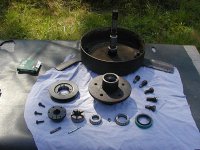Congratulations on finding the problem!
If you are having poor connection problems, you may want to go through each connector in your wiring, open it up, clean the contacts (with a pencil eraser or fine sandpaper), coat it with dielectric grease and reassemble. It is a pain in the popo, but you will find the corroded, loose, arcing, and mis-crimped connections. Of course, you can just cut off the old ones and put on new ones, if you have enough wire...
I'm a big fan of the crimp on wire connectors that have a heat liquifing sealant in them, aka "adhesive lined heat shrink connectors". After you crimp them on the wire, you heat it up, like heat shrink tubing, and they both shrink and force a liquid glue around the wire and insulation. They are great for wire connections out in the weather, like the PT wiring. There is also a version that has low temperature solder that melts in to make a great electrical connection. I get them from
Del City, but West Marine and others sell the Ancor brand.
Good luck on the spindle bearings!
All the best,
Peter

